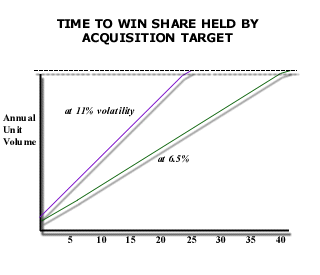ACQUISITIONS: THE BUY OR WIN DECISION
by Donald V. Potter
Acquisitions are back. Mergers and acquisitions, as the Wall Street Journal recently reported, reached record levels in 1995 – and hostile acquisitions are at their highest level since 1988.
The return of the takeover shouldn’t really be a surprise. Many are occurring in industries that are deep into hostility and have been for years. To understand why, in those industries, acquisition makes strategic sense, consider what hostility means for companies trying to survive to better times.
The Prevalence of Hostility
Hostility is common. In recent years, for example, market hostility has struck air express, airlines, beer, cement, computers, copiers, lodging, machine tools, steel, tires, table wine, and trucking. Nearly every industry faces hostility at some time, and many industries experience recurring hostility brightened only briefly by “good times.”
And, once hostility strikes, it lasts. An industry stays hostile for an average of 15 years. Airlines were deregulated in the 1970s and the end of hostility is nowhere in sight. Unfortunately for all suppliers, hostility will not end until the market has gone through the lengthy process to right itself.
The Five Stages of Market Correction
Once a major competitor drops its prices and hostility begins, the industry will pass through five stages.
- Margin Squeeze. As soon as prices start falling, large customersin particular realize that they can demand and get price cuts of up to 25 percent off the industry standard. Any supplier who tries to resist price demands will lose customers, so no one does. All suppliers face shrinking margins.
- Product Proliferation. With price falling to uniformly low levels, suppliers scramble to find something that will set them apart and attract buyers. They try product variations – either by unbundling the product to cut price on one desirable part of the package or by adding benefits to improve the product at its current price. Unfortunately for suppliers, their moves can be copied quickly by competitors.
- Cutting To The Bone. Trying to maintain margins, suppliers cut fat, then flesh. Service cuts, though, can be self defeating because customers notice. Once customers see the cuts – once they notice, for example, that quality has slipped, response time is slower, or service staff has been reduced – they will leave.
- Consolidation and Shakeout. With nothing left to try, some competitors simply fold their tents, and others are acquired. When one competitor swallows another, operations are consolidated and overhead reduced. The result is fewer competitors but tougher competition since the remaining companies are larger and leaner – in other words, fitter.
- Relief. Permanent relief occurs only when a handful of competitors control about 85 percent of the industry, are satisfied with their share, and decide to stop discounting prices in attempts to win share.
Acquisition as a Strategic Response
The key to surviving hostility is to gain market share. Greater sales volume helps a company move further down the cost curve more quickly by enabling the company to spread costs over a larger sales base.
Earning share, though, is difficult even in the best of times. All things being equal, customers tend to stay in existing relationships; for any satisfied customer, the status quo is the easiest, safest, and least expensive course of action. Most customers leave only when a supplier fails them, and good competitors fail much less often than the bad competitors.

It is difficult to earn significant share. A leading supplier in a non-hostile industry became the acquisition target of a competitor. If the acquisition target were to fail at the industry average rate, losing 11 percent of its share each year, and the acquiring competitor were to pick up a disproportionate share of the volume available through that failure, that acquirer would still need 22 years to pick up the entire market share. Rarely, though, do good competitors fail at the industry average rate. In this case, the acquisition target failed at only half the industry average, or 6.5 percent per year, so the acquirer would need about the 40 years to gain all of the target’s share.
(Note: This Perspective was written in the context of the economy in 1996. While some of the companies may have changed their policies or indeed no longer exist, the patterns they exhibit still hold today.)
| Recommended Reading |
| For a greater overall perspective on this subject, we recommend the following related items:
Analyses:
Symptoms and Implications: Symptoms developing in the market that would suggest the need for this analysis.
*** |
